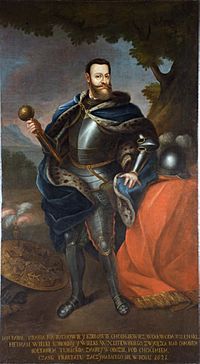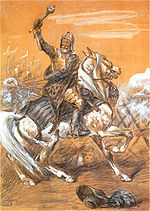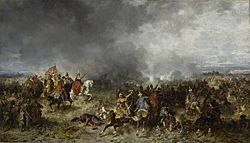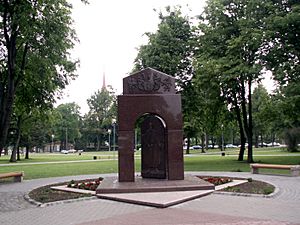Jan Karol Chodkiewicz facts for kids
Quick facts for kids
Hetman
Jan Karol Chodkiewicz |
|
|---|---|
 Chodkiewicz wearing a traditional costume of Polish magnates
|
|
| Coat of arms | Chodkiewicz coat of arms |
| Born | c. 1561 Vilnius, Grand Duchy of Lithuania |
| Died | 24 September 1621 Khotyn Castle, Poland |
| Noble family | Chodkiewicz |
| Spouse(s) | Zofia Mielecka Anna Alojza Ostrogska |
| Issue | Hieronim Chodkiewicz Anna Scholastyka Chodkiewicz |
| Father | Jan Hieronimowicz Chodkiewicz |
| Mother | Krystyna Zborowska |
Jan Karol Chodkiewicz (Lithuanian: Jonas Karolis Chodkevičius, Belarusian: Ян Караль Хадкевіч ; born around 1561 – died 24 September 1621) was a very important military leader. He served the Grand Ducal Lithuanian Army. From 1601, he was the Field Hetman of Lithuania, and from 1605, the Grand Hetman of Lithuania. A "hetman" was a top military commander.
He was one of the most famous noblemen and army commanders of the Polish-Lithuanian Commonwealth during his time. His family's symbol, or coat of arms, was the Chodkiewicz.
Chodkiewicz played a big role in many wars. He was often the main commander for the Commonwealth army. He fought in the Wallachian campaign (1599–1601), the Polish–Swedish War (1600–11), the Polish–Muscovite War (1605–18), and the Polish–Ottoman War (1620–1621).
His most famous victory was the Battle of Kircholm in 1605. There, his army defeated a Swedish army that was three times larger than his own. He died while fighting at the Battle of Khotyn in 1621. This happened just a few days before the Ottomans decided to stop their attack and talk about peace.
Contents
Biography of Jan Karol Chodkiewicz
Early Life and Military Start
Jan Karol Chodkiewicz was born around 1561. We don't know the exact date. His father was Jan Hieronimowicz Chodkiewicz, a high-ranking official in Lithuania. His mother was Krystyna Zborowska, from a powerful Polish noble family.
From 1573, he studied at the Jesuit College in Vilnius and at Vilnius University. From 1586 to 1589, he studied in other countries, including at the University of Ingolstadt. He also visited Padua before coming back to the Polish-Lithuanian Commonwealth in 1590.
He started his military career soon after returning home. He led a small group of 50 to 100 soldiers. He gained experience fighting against rebellious Cossacks during the Nalyvaiko uprising. He took part in battles like Kaniów in 1596. In 1599, he became the Elder of Samogitia, a leadership position.
Chodkiewicz later helped Jan Zamoyski, another top commander, in his successful Wallachian campaign. Chodkiewicz fought in the Battle of Ploiești in 1600. Because of his success, he was given the important job of Field Lithuanian Hetman that year. This made him the second-in-command of the Lithuanian army.
Fighting in the Northern Wars
In 1601, Chodkiewicz went north with Zamoyski to Duchy of Livonia. There, he led Lithuanian soldiers in the war against Sweden. He helped win the battle of Kokenhausen in July 1601. After Zamoyski went back to Poland in 1602, Chodkiewicz took charge of the fighting in Livonia.
In April 1603, he captured Dorpat (now Tartu). He also defeated Swedish forces at the Battle of Weissenstein in September 1604. His greatest achievement was the huge victory at the Battle of Kircholm (modern Salaspils) on 27 September 1605. With only about 4,000 soldiers, mostly Winged Hussar cavalry, he completely defeated a Swedish army three times his size.
For this amazing victory, he received praise from many leaders. This included Pope Paul V, many Catholic kings, and even the Sultan of the Ottoman Empire and the Shah of Persia. Soon after, he was given the highest military rank, Grand Hetman of Lithuania. He also received land and money from the king.
However, this great victory didn't lead to much more success. The Sejm (the Commonwealth parliament) couldn't agree on how to pay for the war. Chodkiewicz stayed loyal to King Sigismund III Vasa. He helped the king defeat the Zebrzydowski rebellion in 1606–1607. He led the army's right side during the Battle of Guzów in July 1607, where the rebels were defeated. He then stopped unrest in Lithuania, fighting against another powerful nobleman, Janusz Radziwiłł.
In 1609, the Swedes invaded Livonia again. Chodkiewicz went back and helped Riga. He also recaptured Pernau. He even created a small fleet and surprised the Swedish Navy at the Battle of Salis.
Wars in the East and South
Around this time, the Dimitriad wars with Muscovy began. King Sigismund III started this war, but many Lithuanian nobles, including Chodkiewicz, didn't like it. Chodkiewicz was so unhappy that he lost the king's favor for a while. Eventually, they settled their differences, and Chodkiewicz was sent to fight the Muscovites. He first operated near Smolensk and Pskov.
Polish–Lithuanian forces started winning battles, like the capture of Smolensk. Some leaders even dreamed of a huge Polish–Lithuanian–Muscovite Commonwealth. The king asked Chodkiewicz to advance on Moscow. But again, the Sejm didn't pay the soldiers, which led to some units rebelling. Chodkiewicz fought several battles against the Muscovites in late 1611 but then had to retreat. He was disappointed and criticized the campaign in 1613.
For the next few years (1613–1615), Chodkiewicz defended the areas the Commonwealth had gained around Smolensk. He also dealt with unrest in Lithuania. The war became more offensive only when the crown prince, Władysław, arrived with more soldiers. The army, led by Władysław but really commanded by Chodkiewicz, captured the Dorogobuzh fortress in October 1617. The siege of Mozhaysk in December of the next year was not successful, and this ended the conflict.

Right after the Polish-Muscovite War ended, Chodkiewicz was quickly sent south. He had to defend the border against the Turks. In the early part of the Polish–Ottoman War, the Turks defeated Polish forces at Cecora. A huge army of 160,000 Turks and 60,000 Tatars, led by Sultan Osman II himself, marched towards the Polish border.
The Commonwealth forces had about 70,000 soldiers. Half of them were Cossacks led by Petro Konashevych-Sahaidachny. In September 1621, Chodkiewicz crossed the Dnieper and set up defenses in the Khotyn Fortress. This was directly in the path of the Ottoman army. During the Battle of Khotyn, Chodkiewicz's army held off the Sultan's 200,000-strong army for a whole month.
However, this victory cost him his life. A few days before the siege ended and the Ottomans decided to negotiate, the old Grand Lithuanian Hetman died. He had been sick since the start of the campaign. He passed away in the fortress on 24 September 1621.
Chodkiewicz's body was taken to Kamianets-Podilskyi, where he was buried on 14 October 1621. A few years later, in 1622, his wife had his body moved. He was reburied in Ostroh in June that year. In 1627, he was moved again to a new chapel in Ostroh. His body was moved from Ostroh during the Khmelnytsky Uprising in 1648 and returned in 1654. He was reburied one more time in a new tomb in Ostroh in 1722.
Jan Karol Chodkiewicz: His Legacy
In 1937, historian Wanda Dobrowolska wrote that Chodkiewicz was one of the most important leaders of the "Great Hetman era." He was known for his skills as a military planner and organizer. She noted that Chodkiewicz had a very strong will. He could make his soldiers follow his orders. He was an effective commander, but his troops respected and feared him more than they loved him. Dobrowolska also said he was energetic and quick-tempered. This was different from Stanisław Żółkiewski, another great hetman of that time, whom Chodkiewicz didn't like and often competed with.
Chodkiewicz wasn't very involved in the Commonwealth's everyday politics. However, his high position and wealth gave him a lot of power. He mostly used his political influence to get support for his military plans. He wanted to make the armies bigger and gain personal rewards. His life was mostly about warfare. If he wasn't fighting on the battlefield, he was fighting politically against other Lithuanian nobles, especially the Radziwiłł family. He also argued with politicians in the Sejm. He blamed them for not raising enough money to support the armies he needed.
Over his career, he became very wealthy. He used his money to fund many churches and other important buildings. He often worked with the Jesuits, even paying for their college in Kražiai. He believed his service should be rewarded with land. But he also often used his own money to pay for military costs. In his private life, he was known as a very proud person. He emphasized his identity as a member of the Lithuanian nobility.
He was a family man. He was devoted to his family. However, his only son, from his marriage to Zofia Mielecka in 1593, died at age 16 in 1613. His first wife died in 1618. He remarried in 1620, wedding Anna Alojza Ostrogska in November 1620. This was shortly before he left for his last military campaign. Also in that year, his daughter Anna married a Lithuanian nobleman, Jan Stanisław Sapieha.
Some poems and other writings praising Chodkiewicz were created during his lifetime. A religious book was dedicated to him by the Jesuit Piotr Skarga. More works about Chodkiewicz were written after his death. He was a character in Wacław Potocki's long novel about the Khotyn war. He also appeared in works by Julian Ursyn Niemcewicz and Zofia Kossak-Szczucka. In these stories, he was usually shown as a patriot and a brilliant military leader.
In 2021, ceremonies were held in Lithuania to mark 400 years since his death. A monument to Jan Karol Chodkiewicz was revealed in Vilnius. A new Lithuanian award, the Jonas Karolis Chodkevičius Gold Medal, was also created. In Kretinga, which Chodkiewicz founded in 1602, a special memorial was placed. This was in the Chodkiewicz family crypt at the Church of the Annunciation to the Blessed Virgin Mary. He had asked to be buried there with his first wife and sons. However, his remains were buried in Ukraine by his second wife, and that church was destroyed later. Also, the Lithuanian Armed Forces Motorized Infantry Brigade Žemaitija was renamed in his honor.
See also
 In Spanish: Jan Karol Chodkiewicz para niños
In Spanish: Jan Karol Chodkiewicz para niños
- Military of the Polish–Lithuanian Commonwealth






